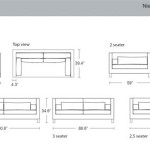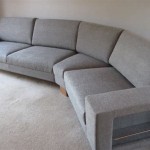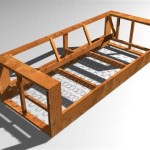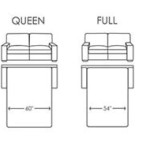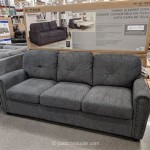Standard Sofa Seat Height: A Comprehensive Guide
Choosing the right sofa involves considering various factors, and seat height plays a crucial role in overall comfort and functionality. Understanding standard sofa seat heights, and how they interact with other furniture dimensions, is essential for creating a harmonious and comfortable living space.
What is Standard Sofa Seat Height?
Standard sofa seat height typically falls between 17 and 19 inches, measured from the floor to the top of the seat cushion. This range accommodates the average adult height and allows for comfortable sitting and rising. While this range represents the norm, variations exist depending on sofa style and intended use.
Factors Influencing Sofa Seat Height
Several factors influence the ideal sofa seat height, contributing to the variations found across different styles and designs.
Key Considerations for Seat Height
Selecting the appropriate sofa seat height requires considering several crucial factors to ensure optimal comfort and practicality.
1. User Height and Body Type
Taller individuals may find higher seat heights more comfortable, while shorter individuals might prefer lower seats. Consider the primary users of the sofa and their physical characteristics when selecting a suitable height.
2. Sofa Style and Design
Different sofa styles often feature varying seat heights. For instance, a low-slung, modern sofa might have a lower seat height than a traditional, more upright design. Consider the overall aesthetic and intended use when choosing a particular style.
3. Existing Furniture and Room Dimensions
The height of other furniture in the room, particularly coffee tables and end tables, should complement the sofa's seat height. Ensure adequate clearance and proportional relationships between furniture pieces. Room dimensions also play a role; a lower sofa can make a small room feel more spacious, while a higher sofa can anchor a larger room.
4. Cushion Type and Fill
The type of cushion and its fill material can significantly impact the perceived seat height. Overstuffed cushions might sit higher and feel firmer, while softer cushions might compress more, resulting in a lower effective seat height. Consider the desired level of firmness and how it relates to the overall seat height.
Measuring Sofa Seat Height
Accurate measurement is crucial for determining the suitability of a sofa's seat height. Follow these steps for precise measurement:
1. Use a Tape Measure
Employ a standard tape measure to obtain accurate measurements. Ensure the tape measure is properly calibrated and held taut.
2. Measure from the Floor
Place the end of the tape measure on the floor, directly beneath the front edge of the seat cushion.
3. Measure to the Top of the Cushion
Extend the tape measure vertically to the highest point of the seat cushion. This measurement represents the sofa's seat height.
4. Account for Cushion Compression
Keep in mind that cushions will compress over time. Consider the potential compression when assessing the long-term seat height and its impact on comfort.
Common Sofa Seat Heights and Styles
Different sofa styles often correlate with specific seat height ranges. Understanding these relationships can assist in narrowing down choices based on desired aesthetic and functionality.
Low-Profile Sofas
These sofas often feature seat heights lower than 17 inches, creating a modern, minimalist aesthetic. They can make a room feel more spacious and offer a relaxed seating experience.
Mid-Century Modern Sofas
Typically featuring seat heights between 17 and 18 inches, these sofas offer a balance of comfort and style, often with tapered legs and clean lines.
Traditional Sofas
Traditional sofas usually have seat heights within the standard range of 17 to 19 inches, providing a comfortable and familiar seating experience.
High-Back Sofas
These sofas might have higher seat heights to accommodate the taller backrest, providing enhanced support and a more formal look.
Impact of Seat Depth and Back Height
While seat height is a critical factor, it's essential to consider seat depth and back height in conjunction with seat height for optimal comfort. A deeper seat may require a slightly higher seat height to maintain proper posture, while a shallower seat may pair well with a lower seat height. The back height also plays a role in overall support and comfort, and should be considered alongside seat height and depth.
Ergonomic Considerations
Ergonomics play a crucial role in sofa comfort and long-term well-being. A sofa with the appropriate seat height, depth, and back height can promote good posture and reduce strain on the back and joints. Consider ergonomic principles when selecting a sofa to ensure optimal support and comfort.
Testing Sofa Seat Height
Whenever possible, physically testing a sofa before purchasing is highly recommended. Sit on the sofa for several minutes to assess its comfort and suitability. Pay attention to how your feet rest on the floor, the angle of your knees, and the support provided by the backrest. This practical experience can provide valuable insights beyond measurements alone.

Sofa Dimensions 101 Measuring For Your Perfect

Six Common Mistakes When A Sofa And Ways To Avoid Them

Standard Sofa Dimensions For 2 3 4 And 5 Person Charts Diagrams Styling
Your Guide To Measuring For Sofa

Sofa Size Calculator

Guide To Standard Sofa Dimensions In Inches The Home S Diy Single Seater

Sofa Dimensions For 2 3 4 5 6 Person Couches Diagrams Included Home Stratosphere

Standard Sofa Dimensions For 2 3 4 And 5 Person Charts Diagrams Engineering Discoveries

The Taylor Custom Petite Roll Arm Sofas Sectionals More Of Iron Oak

Standard Sofa Dimensions For 2 3 4 And 5 Person Charts Diagrams Engineering Discoveries

